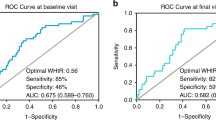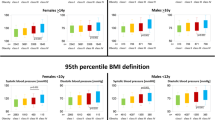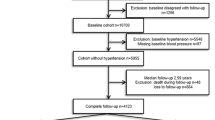Abstract
Background and objectives
Adult class II/III obesity (BMI ≥ 35 kg/m2) has significant adverse health outcomes. Early prevention and treatment are critical, but prospective childhood risk estimates are lacking. This study aimed to define the prospective risk of adult class II/III obesity, using childhood BMI.
Methods
Children ages 3–19 years enrolled in cohorts of the International Childhood Cardiovascular Cohort (i3C) consortium with measured BMI assessments in childhood and adulthood were included. Prospective risk of adult class II/III obesity was modeled based on childhood age, sex, race, and BMI.
Results
A total of 12,142 individuals (44% male, 85% white) were assessed at median age 14 [Interquartile range, IQR: 11, 16] and 33 [28, 39] years. Class II/III adult obesity developed in 6% of children with normal weight; 29% of children with overweight; 56% of children with obesity; and 80% of children with severe obesity. However, 38% of the 1440 adults with class II/III obesity (553/1440) were normal weight as children. Prospective risk of adult class II/III obesity varied by age, sex, and race within childhood weight status classifications, and is notably higher for girls, black participants, and those in the United States. The risk of class II/III obesity increased with older adult age.
Conclusions
Children with obesity or severe obesity have a substantial risk of adult class II/III obesity, and observed prospective risk estimates are now presented by age, sex, race, and childhood BMI. Clinical monitoring of children’s BMI for adult class II/III obesity risk may be especially important for females and black Americans.
This is a preview of subscription content, access via your institution
Access options
Subscribe to this journal
Receive 12 print issues and online access
$259.00 per year
only $21.58 per issue
Buy this article
- Purchase on Springer Link
- Instant access to full article PDF
Prices may be subject to local taxes which are calculated during checkout


Similar content being viewed by others

References
Global Burden of Disease 2015 Obesity Collaborators, Afshin A, Forouzanfar MH, Reitsma MB, Sur P, Estep K, et al. Health effects of overweight and obesity in 195 countries over 25 years. N Engl J Med. 2017;377:13–27.
Flegal KM, Kit BK, Orpana H, Graubard BI. Association of all-cause mortality with overweight and obesity using standard body mass index categories: a systematic review and meta-analysis. JAMA. 2013;309:71–82.
Gadde KM, Martin CK, Berthoud HR, Heymsfield SB. Obesity: Pathophysiology and Management. J Am Coll Cardiol. 2018;71:69–84.
Backholer K, Wong E, Freak-Poli R, Walls HL, Peeters A. Increasing body weight and risk of limitations in activities of daily living: a systematic review and meta-analysis. Obes Rev. 2012;13:456–68.
Finkelstein EA, Ostbye T, Malhotra R. Body mass trajectories through midlife among adults with class I obesity. Surg Obes Relat Dis. 2013;9:547–53 e1.
Wong ES, Wang BC, Alfonso-Cristancho R, Flum DR, Sullivan SD, Garrison LP, et al. BMI trajectories among the severely obese: results from an electronic medical record population. Obesity. 2012;20:2107–12.
Fildes A, Charlton J, Rudisill C, Littlejohns P, Prevost AT, Gulliford MC. Probability of an obese person attaining normal body weight: cohort study using electronic health records. Am J Public Health. 2015;105:e54–9.
Gero D, Favre L, Allemann P, Fournier P, Demartines N, Suter M. Laparoscopic Roux-En-Y gastric bypass improves lipid profile and decreases cardiovascular risk: a 5-year longitudinal cohort study of 1048 patients. Obes Surg. 2018;28:805–811.
Inge TH, Jenkins TM, Xanthakos SA, Dixon JB, Daniels SR, Zeller MH, et al. Long-term outcomes of bariatric surgery in adolescents with severe obesity (FABS-5+): a prospective follow-up analysis. Lancet Diabetes Endocrinol. 2017;5:165–73.
Olbers T, Beamish AJ, Gronowitz E, Flodmark CE, Dahlgren J, Bruze G. et al. Laparoscopic Roux-en-Y gastric bypass in adolescents with severe obesity (AMOS): a prospective, 5-year, Swedish nationwide study. Lancet Diabetes Endocrinol. 2017;5:174–83.
Goodman E, Dolan LM, Morrison JA, Daniels SR. Factor analysis of clustered cardiovascular risks in adolescence: obesity is the predominant correlate of risk among youth. Circulation. 2005;111:1970–7.
Freedman DS, Dietz WH, Tang R, Mensah GA, Bond MG, Urbina EM, et al. The relation of obesity throughout life to carotid intima-media thickness in adulthood: the Bogalusa Heart Study. Int J Obes Relat Metab Disord. 2004;28:159–66.
Freedman DS, Khan LK, Serdula MK, Dietz WH, Srinivasan SR, Berenson GS. Racial differences in the tracking of childhood BMI to adulthood. Obes Res. 2005;13:928–35.
Bayer O, Kruger H, von Kries R, Toschke AM. Factors associated with tracking of BMI: a meta-regression analysis on BMI tracking. Obesity. 2011;19:1069–76.
Abdullah A, Wolfe R, Stoelwinder JU, de Courten M, Stevenson C, Walls HL, et al. The number of years lived with obesity and the risk of all-cause and cause-specific mortality. Int J Epidemiol. 2011;40:985–96.
Everhart JE, Pettitt DJ, Bennett PH, Knowler WC. Duration of obesity increases the incidence of NIDDM. Diabetes. 1992;41:235–40.
Dwyer T, Sun C, Magnussen CG, Raitakari OT, Schork NJ, Venn A, et al. Cohort profile: the international childhood cardiovascular cohort (i3C) consortium. Int J Epidemiol. 2013;42:86–96.
Sinaiko AR, Jacobs DR Jr., Woo JG, Bazzano L, Burns T, Hu T, et al. The international childhood cardiovascular cohort (i3C) consortium outcomes study of childhood cardiovascular risk factors and adult cardiovascular morbidity and mortality: Design and recruitment. Contemp Clin Trials. 2018;69:55–64.
Cole TJ, Lobstein T. Extended international (IOTF) body mass index cut-offs for thinness, overweight and obesity. Pediatr obesity. 2012;7:284–94.
Ward ZJ, Long MW, Resch SC, Giles CM, Cradock AL, Gortmaker SL. Simulation of growth trajectories of childhood obesity into adulthood. N Engl J Med. 2017;377:2145–53.
Venn AJ, Thomson RJ, Schmidt MD, Cleland VJ, Curry BA, Gennat HC, et al. Overweight and obesity from childhood to adulthood: a follow-up of participants in the 1985 Australian Schools Health and Fitness Survey. Med J Aust. 2007;186:458–60.
Crerand CE, Wadden TA, Sarwer DB, Fabricatore AN, Kuehnel RH, Gibbons LM, et al. A comparison of weight histories in women with class III vs. class I-II obesity. Surg Obes Relat Dis. 2006;2:165–70.
O’Connell J, Kieran P, Gorman K, Ahern T, Cawood TJ, O’Shea D. BMI > or = 50 kg/m2 is associated with a younger age of onset of overweight and a high prevalence of adverse metabolic profiles. Public Health Nutr. 2010;13:1090–8.
Richardson AS, Dietz WH, Gordon-Larsen P. The association between childhood sexual and physical abuse with incident adult severe obesity across 13 years of the National Longitudinal Study of Adolescent Health. Pediatr Obes. 2014;9:351–61.
Glueck CJ, Morrison JA, Daniels S, Wang P, Stroop D. Sex hormone-binding globulin, oligomenorrhea, polycystic ovary syndrome, and childhood insulin at age 14 years predict metabolic syndrome and class III obesity at age 24 years. J Pediatr. 2011;159:308–13 e2.
Salahuddin M, Perez A, Ranjit N, Hoelscher DM, Kelder SH. The effect of prenatal maternal cigarette smoking on children’s BMI z-score with SGA as a mediator. Int J Obes. 2018;42:1008–18.
Salahuddin M, Perez A, Ranjit N, Kelder SH, Barlow SE, Pont SJ, et al. Predictors of severe obesity in low-income, predominantly hispanic/latino children: the Texas Childhood Obesity Research Demonstration Study. Prev Chronic Dis. 2017;14:E141.
Salahuddin M, Perez A, Ranjit N, Hoelscher DM, Kelder SH. The associations of large-for-gestational-age and infant feeding practices with children’s body mass index z-score trajectories: the early childhood longitudinal study, birth cohort. Clin Obes. 2017;7:307–15.
Ogden CL, Carroll MD, Kit BK, Flegal KM. Prevalence of obesity and trends in body mass index among US children and adolescents, 1999–2010. JAMA. 2012;307:483–90.
Funding
Funded by the National Institutes of Health, National Heart, Lung and Blood Institute, grant number R01 HL121230.
Author information
Authors and Affiliations
Contributions
JGW conceptualized and designed the study and analysis, contributed to the interpretation of data, drafted the initial manuscript, and revised the manuscript for important intellectual content. NZ and MF carried out the analyses, contributed to drafting the initial manuscript, and revised the manuscript for important intellectual content. DRJ, TH, and JRR made substantial contributions to the analysis and interpretation of data, and revised the manuscript for important intellectual content. OR, TD, and AS contributed to the acquisition and interpretation of data, and revised the manuscript for important intellectual content. JS, EMU, TLB, LB, and SRD coordinated and supervised data collection and reviewed and revised the manuscript. RJP, CJ, and MJ contributed to the interpretation of data and reviewed and revised the manuscript. AV conceptualized the study, coordinated, and supervised data collection, contributed to the interpretation of the data, and critically revised the manuscript for important intellectual content. All authors approved the final manuscript as submitted and agree to be accountable for all aspects of the work.
Corresponding author
Ethics declarations
Conflict of interest
The authors declare that they have no conflict of interest.
Additional information
Publisher’s note Springer Nature remains neutral with regard to jurisdictional claims in published maps and institutional affiliations.
Supplementary information
Rights and permissions
About this article
Cite this article
Woo, J.G., Zhang, N., Fenchel, M. et al. Prediction of adult class II/III obesity from childhood BMI: the i3C consortium. Int J Obes 44, 1164–1172 (2020). https://doi.org/10.1038/s41366-019-0461-6
Received:
Revised:
Accepted:
Published:
Issue Date:
DOI: https://doi.org/10.1038/s41366-019-0461-6
This article is cited by
-
A multi-center, randomized, 12-month, parallel-group, feasibility study to assess the acceptability and preliminary impact of family navigation plus usual care versus usual care on attrition in managing pediatric obesity: a study protocol
Pilot and Feasibility Studies (2023)
-
Combined Dyslipidemia in Children and Adolescents: a Proposed New Management Approach
Current Atherosclerosis Reports (2023)
-
Association of body mass index from childhood to mid-adulthood with health-related quality of life in mid-adulthood
Quality of Life Research (2023)
-
Childhood Obesity and Cardiovascular Disease Risk
Current Atherosclerosis Reports (2023)
-
Characterization of the genetic architecture of infant and early childhood body mass index
Nature Metabolism (2022)


